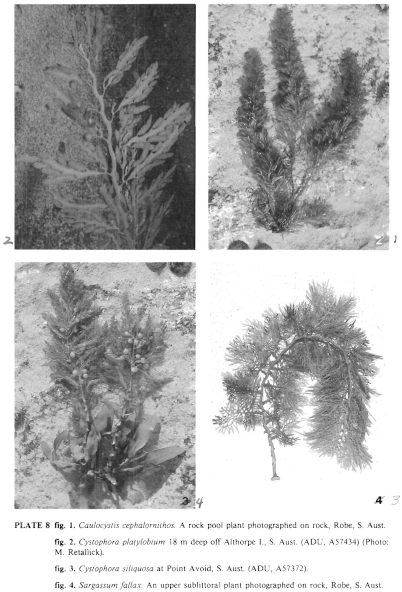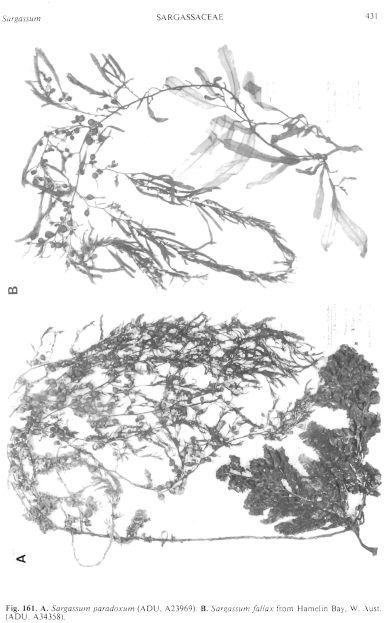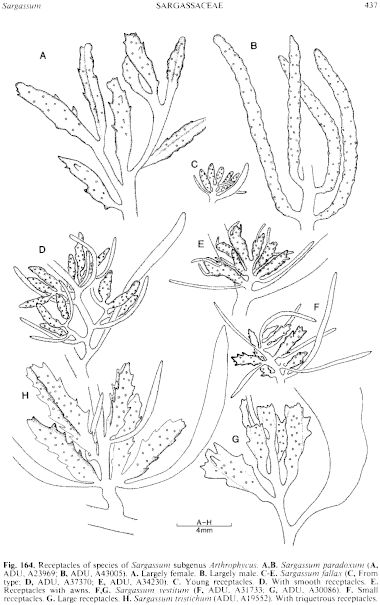|
|
|
|
|
|||||||||||
|
Electronic Flora of South Australia Species Fact Sheet
Phylum Phaeophyta – Order Fucales – Family Sargassaceae
Selected citations: J. Agardh 1848: 297; 1872: 66; 1889: 68, pl. 20 figs 1–7. Grunow 1915: 356.
Synonyms
Blossevillea fallax (Sonder) Kützing 1849: 631; 1860: 31, p1.87.
Sargassum bracteolosum J. Agardh 1889: 67, pls 4,19 figs 2–5. Grunow 1915: 355. Lucas 1936: 66.
Thallus (Pl. 8 fig. 4; Figs 161B, 162A) medium to dark brown, 20–100 cm long, with stipes 1–4 (–7) cm long, terete, simple, 2–4 mm in diameter, relatively smooth, bearing apically 1–4 primary branches. Holdfast discoid-conical, 5–20 mm across, with a single stipe; epilithic. Primary branches 10–50 (–90) cm long, with robust, triquetrous, axes bearing tristichously arranged laterals below, and much branched laterals above. Laterals (lower) basally retroflex, simple, 4–10 (–25) cm long, 0.5–1.5 (–2) cm broad, costate, more or less flat and smooth with entire margins, rarely with age becoming slightly to moderately spinous; intermediate laterals 2–10 mm broad, margins entire to incised; upper laterals grading, often abruptly (especially on older branches) from lower laterals, 1–3 cm long and much branched above with compressed to terete, filiform, branches 0.3–1 mm broad, usually lost as the branch ages. Vesicles usually abundant on upper laterals, petiolate, subspherical, 5–10 mm in diameter, mucronate or with a terminal leaflet (to 1.5 cm long).
Reproduction: Thalli monoecious. Receptacles (Fig. 164C–E) bisexual or unisexual, in dense racemose clusters (Fig. 164D,E) on upper, subterete, laterals, each 1–2.5 (–4) mm long and 300–900 µm broad, petiolate, simple or occasionally with a branch and often bearing 1 (–2) sterile, lateral awns (Fig. 164E), terete and short-lanceolate or occasionally slightly compressed above, smooth when young (Fig. I64C), slightly verrucose when older, usually without spines but eastern plants often with one or two spines on the upper part, with scattered ostioles. Conceptacles usually unisexual, occasionally bisexual; oogonia sessile, ovoid, 150–250 µm long and 110–140 gm in diameter, few per conceptacle; antheridia sessile or on short branched paraphyses, ovoid, 14–20 µm long and 10–14 µm in diameter.
Type from W. Aust. (Preiss); in MEL, lectotype 687512, isolectotype 687513.
Selected specimens: Between Coronation Group and Basile I., Houtman Abrolhos, W. Aust., trawled (Keating, 24.viii.1970; ADU, A43824). 7 mile Beach, N. of Dongara, W. Aust., drift (Womersley, 17.ix.1979; ADU, A51350). Hamelin Bay, W. Aust., drift (Gordon, 16.xi.1968; ADU, A34358). Hopetoun, W. Aust., drift (Gordon, 20.xi.1968; ADU, A34129). Eyre, W.
Distribution: From Houtman Abrolhos, W. Aust. around southern Australia and Tasmania to Ballina, N.S.W. (May 1939, p. 202).
Taxonomic notes: Aust., drift ( Woelkerling, 22.xi.1968; ADU, A34230). Egg I., Isles of St Francis, S. Aust., 32–38 m deep (Shepherd, 11.i.1971; ADU, A38105). Venus Bay, S. Aust., sublittoral fringe (Womersley, 12.ii.1954; ADU, A19510). Waldegrave I., S. Aust., 22 m deep (Shepherd, 23.x.1970; ADU, A37370). Pearson I., S. Aust., 48 m deep (Shepherd, 9.i.1969; ADU, A33709). Wedge I., S. Aust., 8–10 m deep (Baldock, 29.xii.1963; ADU, A27255). Port Noarlunga, S. Aust., upper sublittoral (Baldock, 7.xii.1965; ADU, A30491). Aldinga, S. Aust., 1–3 m deep (Lewis, 7.xii.1972; ADU, A42895-"Marine Algae of southern Australia" No. 293). Pennington Bay, Kangaroo I., S. Aust., upper sublittoral pools (Womersley, 31.i.1957; ADU, A20777). Robe, S. Aust., drift (Womersley, 13.xi.1955; ADU, A20029). Dutton Beach, Portland, Vic., drift (Beauglehole, 29.xi.1959; ADU, A23978). Hinders, Vic., upper sublittoral ( Womersley, 18.i.1967; ADU, A31797). Walkerville, Vic., drift ( Womersley, 11.xi.1982; ADU, A55357). Greens Beach, N. Tas., drift ( Womersley, 9.xi.1982; ADU, A55578).
S. bracteolosum J. Agardh (lectotype in Herb. Agardh, LD, 2044) from Tasmania (probably the north coast) is here united with the older S. fallax, since the variation in basal lateral sizes, in the receptacles (terete to slightly compressed above) and the absence or presence of awns (similar to adjacent ramuli) appear to be variable features; such differences are considered due to age, growth or ecological differences.
S. fallax is a common species on southern Australian coasts, in rock pools or the uppermost sublittoral but extending to 48 m deep. In the eastern part of its range plants with more odd spines occur, possibly intergrades with S. vestitum. The latter, however, has distinctly compressed receptacles with several prominent spines compared to the essentially terete receptacles, often with lateral awns, and no, or only rarely with, a spine; the vesicles of S. fallax are subspherical when mature while those of S. vesititum are ovoid to ellipsoid.
S. fallax was recorded to Rockingham Bay, Qld, by Sonder (1871, p. 40) but this record needs checking.
References:
AGARDH, J.G. (1848). Species, Genera et Ordines Algarum. Vol. 1. (Gleerup: Lund.)
AGARDH, J.G. (1872). Till algernes systematik. Ada Univ. lund. 9(8), 1–71.
AGARDH, J.G. (1889). Species Sargassorum Australiae. K. Svenska Vetenskapsakad. Handl. 23(3), 1–133, Plates 1–31.
GRUNOW, A. (1915). Additamenta ad cognitionem Sargassorum. Verh. Zool. -Bot. Wien 65, 329–448.
KÜTZING, F.T. (1849). Species Algarum. (Leipzig.)
KÜTZING, F.T. (1860). Tabulae Phycologicae. Vol. 10. (Nordhausen.)
LUCAS, A.H.S. (1936). The Seaweeds of South Australia. Part 1. Introduction and the Green and Brown Seaweeds. (Govt Printer: Adelaide.)
MAY, V. (1939). A key to the marine algae of New South Wales. Part. II. Melanophyceae (Phaeophyceae). Proc. Linn. Soc. N.S.W. 64, 191–215.
SONDER, O.W. (1845). Nova Algarum genera et species, quas in itinere ad oras occidentales Novae Hollandiae, collegit L. Preiss. Bot. Ztg 3, 49–57.
SONDER, O.W. (1848). Algae. In Lehmann, C., Plantae Preissianae. Vol. 2, pp. 161–195. (Hamburg.)
SONDER, O.W. (1871). Die algen des tropischen Australiens. Abh. Nat. Ver. Hamburg 5(2), 33–74, Plates 1–6.
The Marine Benthic Flora of Southern Australia Part II complete list of references.
Publication:
Womersley, H.B.S. (14 December, 1987)
The Marine Benthic Flora of Southern Australia
Part II
©Board of the Botanic Gardens and State Herbarium, Government of South Australia
Illustrations in Womersley Part II, 1997: PLATE 8 fig. 4; FIGS 161B, 162A, 164 C–E.

Plate 8 enlarge
PLATE 8 fig. 1. Caulocystis cephalornithos. A rock pool plant photographed on rock, Robe, S. Aust.
fig. 2. Cystophora platylobium 18 m deep off Althorpe I., S. Aust. (ADU, A57434) (Photo: M. Retallick).
fig. 3. Cystophora siliquosa at Point Avoid, S. Aust. (ADU, A57372).
fig. 4. Sargassum fallax. An upper sublittoral plant photographed on rock, Robe, S. Aust.

Figure 161 enlarge
Fig. 161. A. Sargassum paradoxum (ADU, A23969). B. Sargassum fallax from Hamelin Bay, W. Aust. (ADU, A34358).

Figure 162 enlarge
Fig. 162. A. Sargassum fallax from N. Tasmania (ADU, A55578). B. Sargassum vestuum (ADU, A 19141).

Figure 164 enlarge
Fig. 164. Receptacles of species of Sargassum subgenus Arthrophycus. A,B. Sargassum paradavum (A, ADU, A23969; B, ADU, A43005). A. Largely female. B. Largely male. C–E. Sargassum fallax ( C, From type; D, ADU, A37370; E, ADU, A34230). C. Young receptacles. D. With smooth receptacles. E. Receptacles with awns. F,G. Sargassum vestitum ( F, ADU. A31733; G, ADU, A30086). F. Small receptacles. G. Large receptacles. H. Sargassum tristichum (ADU, A19552). With triquetrous receptacles.

|
Email Contact: State Herbarium of South Australia |

|